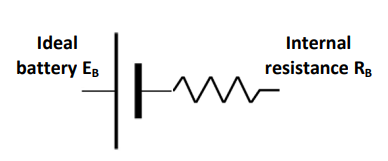Boost charging is a very necessary activity during the operation of a VRLA battery in their life time. In this article we are going to discuss about the necessity of Boost charging in details.
The following example helps illustrate two facts about reducing battery recharge time:
Because no battery materials are superconducting, and because ions must physically move through the battery, all batteries to some degree resist current flow. Therefore any storage battery can be thought of as an ideal battery in series with electrical resistance. Assume in the example below that ideal battery EB is connected in series with resistance RB.

We will compare the battery’s state of charge when it is charged with a 20A charger versus a 40A charger. We assume for purposes of this example that RB is .001 ohms (this is an oversimplified value as the internal resistance will vary with type of cell and state‐of‐charge). The equation below states that a voltage applied to an ideal battery (EB) equals the voltage delivered by the charger at the battery terminals, minus the voltage lost in the battery’s internal resistance (RB) as heat.
If we apply a charge current of 20 amps that is voltage limited to 2.25 volts/cell, EB (which corresponds to the state of charge of the battery) will be:
2.25 = EB + (20* RB)
2.25 = EB + (20* .001)
2.25 = EB + (.02)
2.23 = EB
When charged by the 20A charger, the ideal battery sees 2.23 volts/cell.
If we apply a charge current of 40 amps that is voltage limited to 2.25 volts/cell, EB will be:
2.25 = EB + (40* RB)
2.25 = EB + (40* .001)
2.25 = EB + (.04)
2.21 = EB
When charged by the 40A charger, the ideal battery sees 2.21 volts/cell. At this voltage the ideal battery is able to accept less current than it would at 2.23 volts/cell. In other words it will take longer to recharge the battery at 2.21 volts/cell than it would at 2.23 volts/cell.
In other words, although doubling charging current reduces charging time, it cannot cut charging time in half because the battery’s resistance converts a portion of the additional charging current into waste heat.
In fact, this model understates the problem of resistance losses, because it does not include the significant resistance of cables that connect the charger to the battery. The comparison shows that in order to fully exploit Ideal battery EB Internal resistance RB the current capacity of both the 20A and 40A chargers, charging voltage must be elevated such that higher charging voltage offsets resistance losses both in the battery and in charging cables external to the battery. This elevated voltage is known as “boost” charging.
Let us assume that the charger’s voltage has in fact been increased to a “boost” voltage to enable faster charging. As the battery’s state of charge increases during the course of charging the ideal battery accepts decreasing current. As current diminishes less voltage is lost to heat in the battery’s internal resistance. This exposes the ideal battery to increasing voltage from the constant voltage charging source. If not corrected, this excess voltage would overcharge and damage the ideal battery. To avoid this problem, charging voltage must be reduced as state of charge increases. Although this reduction could be achieved in several steps as current acceptance drops, it is typically achieved in single step to a lower voltage charging value called “float” that allows the battery to accept just enough current after becoming charged to offset its self‐discharge rate.
Charging a battery at maximum speed and with maximum safety means that the transition from boost charge voltage to float charge voltage must occur at the correct time. The correct time is the point at which the battery achieves near full charge, but before damaging overcharge occurs.
***This article is from internet, does not represent the views of this site, if there is any infringement, please contact to delete
Conclusion:
EverExceed has vast experience when it comes to battery solutions, and we are satisfying our partners' and customers’ pain points with the most efficient and precise state of art battery packs consistently. If you have any requirements or any kind of query regarding the battery & power solutions, feel free to communicate with our dedicated team at any time at marketing@everexceed.com
categories
recent posts
scan to wechat:everexceed
